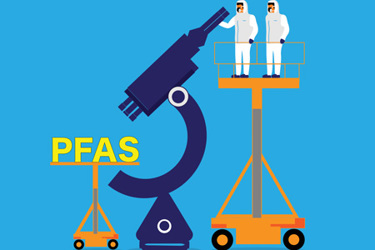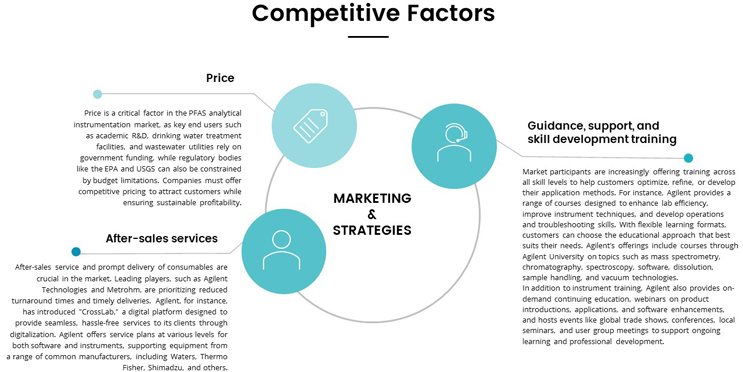PFAS Testing Boom: U.S. Analytical Instrumentation Market Set For Rapid Expansion
By Shilpa Tiku

The U.S. per- and polyfluoroalkyl substances (PFAS) analytical instrumentation market is poised for strong expansion, with a projected CAGR exceeding 20% over the next seven years, according to a new report by Verify Markets.1 Valued at approximately $190 million in 2024, the market is expected to surpass $800 million by 2031. Key drivers in the market include rising concerns over increasing risks associated with PFAS exposure, the U.S. EPA’s federal rule on drinking water, and investments to boost testing and treating PFAS in water.
Commercial testing laboratories dominated the end-user market in 2024 and accounted for an estimated 52% of the market by revenue. Wastewater treatment facilities represented the second-largest segment and held an estimated 17% of market share by revenue. Most utilities rely on commercial labs for PFAS testing due to high instrumentation costs. With new EPA regulations, utilities are likely to become a key end-user market for PFAS analytical instruments. Demand from academic R&D laboratories is expected to stabilize within the next five to six years, while industrial facilities will likely expand testing, emphasizing pretreatment and stricter process controls to curb PFAS discharge.
Over the next five to seven years, drinking water and wastewater testing will see significant growth, while reliance on commercial labs will decline. Currently, commercial labs dominate because early adopters lack in-house capabilities and must outsource testing.
Cost competitiveness – In the PFAS analytical instrumentation market, price sensitivity is high, so companies must be costcompetitive to remain relevant and gain market share. To this end, companies should concentrate on back-end operations and cost control. In addition, it is equally important to maintain flexibility through balancing in-house manufacturing with outsourcing. Optimizing supply chains to remove inefficiencies and establishing solid partnerships with suppliers will likely assist in obtaining better pricing and guarantee product availability.
Consumables supply assurance – Reliable PFAS testing depends on the availability of consumables in a timely manner. During the forecast period (2024-2031), companies will likely leverage AI-driven demand forecasting and robust inventory management in order to prevent shortages and overstocking. Strengthening supply chain resilience and contingency planning will likely ensure operational continuity, reinforcing clients’ trust and market leadership.
Distribution trends – Direct sales remain the primary go-tomarket strategy, a trend unlikely to shift in the near future. While distribution may expand over the next five years, current PFAS-related equipment remains too complex for distributors to manage effectively. Manufacturers favor direct engagement, mitigating risks associated with miscommunication. PFAS analysis represents an emerging and highly complex testing domain, demanding significant education and technical support. Limited availability of expert resources intensifies the challenge. Given the need for continuous training, risk management, and dependable after-sales service, end users prioritize direct sales over distributor channels. Manufacturers align with this preference, with direct sales accounting for over 50% of the market share by revenue, by channel, as they enable tighter control over equipment setup and operation. The specialized nature of PFAS-specific instruments, such as liquid chromatography-tandem mass spectrometry (LCMS/MS) requires extensive hands-on guidance during installation and use, further limiting the role of distributors in the market.

Consolidated market – The overall PFAS analytical instrumentation market is highly consolidated with the top two or three companies holding over 90% of the market share by revenue.
Competitive factors – The key competitive factors within this market include price, after-sales services, and skill development training.
Market share by technology – LC-MS/MS is the predominant technology and is estimated to be over 70% of the market share by revenue in 2024.
The PFAS analytical instrumentation market is on the brink of significant expansion, with analytical instrument manufacturers heavily investing in next-generation solutions. With limited existing techniques and rising demand, companies recognize this as a major growth opportunity and are allocating substantial resources to advance PFAS instrumentation.
Automation is the future of PFAS testing, with major manufacturers prioritizing solutions that streamline the laborintensive sample preparation process. As the industry shifts from manual to automated workflows, demand for these advanced instruments is set to rise, driving significant market growth.
References:
About The Author
 Shilpa Tiku is the chief research officer and partner at Verify Markets (verifymarkets.com). Tiku has more than 20 years of experience in research and consulting. She focuses on monitoring and analyzing emerging trends, technologies, and market dynamics in several global markets. To reach her for comments, interviews, or market consulting, call 210.595.9687 or email her at shilpa.tiku@verifymarkets.com.
Shilpa Tiku is the chief research officer and partner at Verify Markets (verifymarkets.com). Tiku has more than 20 years of experience in research and consulting. She focuses on monitoring and analyzing emerging trends, technologies, and market dynamics in several global markets. To reach her for comments, interviews, or market consulting, call 210.595.9687 or email her at shilpa.tiku@verifymarkets.com.
